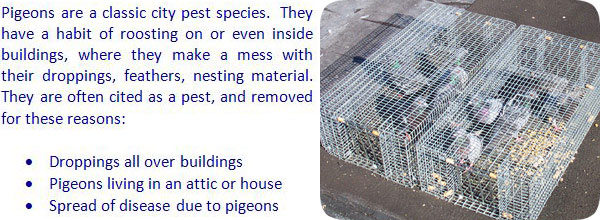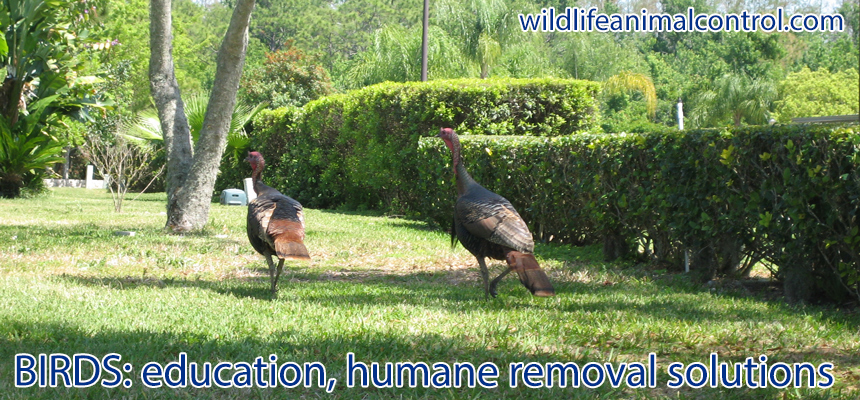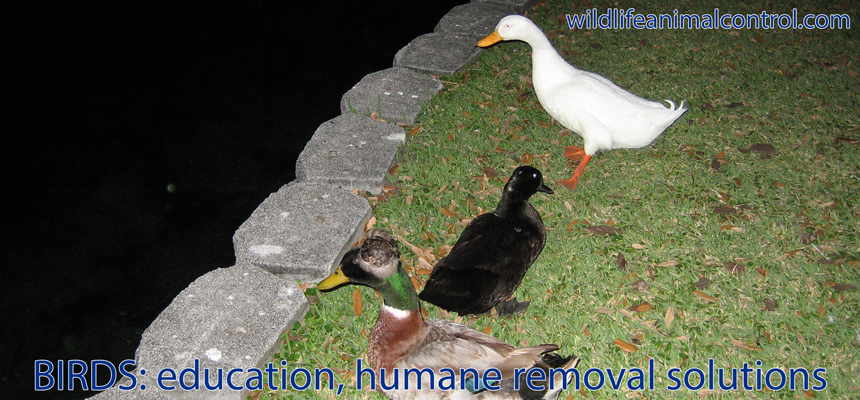- info@wildlifeanimalcontrol.com
Call us for help in your town
Wildlife Control Education
How to Get Rid of Birds on a Building, House, Roof, Attic, Eaves, Gutter

We provide bird control services in over 1700 USA locations - serving the whole USA.
It is my goal to educate the public about nuisance birds, and
provide tips for safe, effective, and responsible wildlife removal. If you need bird control help click here to hire us in your town and check prices - updated for year 2020.
Our bird removal process primarily involves preventing the birds from roosting on a structure, or entering a specific area. We have performed thousands of bird control jobs on every type of structure,
and have a complete understanding of how birds relate to buildings and other structures, how they roost, and how to keep them off or away from an area. Some of the common methods we use include:
Spikes / Needle Strips: Spikes installed on any surface prevent birds from roosting and nesting on that area.
Shock Track: Electrified shock track is the best option for certain types of ledges or structures to keep birds from roosting in the area.
Netting: To keep birds from entering a large area, we install exclusion netting that blocks them out. Our netting is minimally visible and visuall sublte and appealing.
Other Exclusion: We use several other exclusion devices as the situation necessitates. For example spider arms keep birds from roosting in specific areas where spikes don't work.
We handle a wide variety of bird species, all of which require different methods and equipment. Select your bird to learn more about it specifically.
Pigeons,
Canada Geese,
Muscovy Duck,
Starlings,
Woodpecker.

How can you get rid of birds yourself?
In this section, we'll be talking about birds in general, as the following methods work well for a variety of birds. If you're looking for answers, suggestions, or facts about a specific type of bird, scroll on down for specific sections.
1. Set up a scarecrow!
We know, we know, it seems a cliché, but it's nevertheless a really effective way of scaring the birds off your property for good. Luckily for you, scarecrows are easy to find at specialty stores, so you could be the proud owner of a scarecrow by this time tomorrow.
If you are of a more artistic nature or if you're working on a limited budget, you can consider building a scarecrow yourself – it's fun, easier than it seems, and just as effective as a store-bought one!
And if you're stuck for ideas, just check out one of the many tutorials available online.
Why this works: Quite obviously, the birds are scared by the scarecrow since they assume it's a human being who might pose a threat.
Tip: Make sure you move the scarecrow around every few days (or if possible every day, even) and maybe change its clothes. Birds are smarter than they look and they'll eventually figure it out if the scarecrow stays in the exact same place all the time.
2. Shine it up!
Maybe you've seen strings of old CDs adorning your neighbor's porch and thought to yourself “what a cute design”. It's not just a cute thing, but also a great method to deter birds from nesting on your property.
And it's not just old CDs! Tin cans, aluminum foil, mirrors of various shapes and sizes and shiny wrapping paper will all do the job more or less efficiently. What we love about this method is that it has a practical use and it's a great opportunity to redecorate your home!
Why this works: All the above shiny objects are relatively new to the world, which means birds haven't had time to get accustomed to them and acknowledge that they are not a threat. As such, they tend to be rather wary of shiny objects.
3. Get (or make) a predator.
As we all well know, birds are scared of felines, largely because cats love to chase them around and on occasion, to eat the flying creatures. So it's a pretty good bet that if there is a cat near or on your property, this will automatically deter birds from approaching or trying to nest on your property, for fear of catching the cat's unwanted attention.
If you don't own a cat and aren't looking to buy one, not to worry, you can get a similar effect by either using a toy cat (one of those robotized ones for children tend to work well), or even building your own – sort of like a cat scarecrow. Now, as with the human scarecrow, this method is rather tricky, since the birds will eventually notice the cat is motionless. But it's still worth a try.
Other bird predators include owls or larger birds – consider installing a perch for a vulture or some such bird. Not only will the predator's presence discourage other birds from flocking to your property, it will also keep other pests like snakes and raccoons away!
Why this works: Obvious reasons!
4. Install a sprinkler!
If you've got birds popping up uninvited in your yard or on the deck of your home, consider setting up a water sprinkler that is motion activated. This way, whenever a bird tries to settle nearby, a jet of water will gently but firmly tell it to go.
And hey, it's a great way to make sure your lawn and flowers get watered as well, so this is another of those 2-in-1 solutions, how neat is that?
Why this works: While birds like water as much as the next animal, they prefer still, shallow waters from which they can drink and in which they can bathe. The jet of water from the sprinkler is annoying to them and they will likely move away from it. And don't worry, you can get a water sprinkler whose jet isn't actually strong enough to hurt the bird in any way, just enough to deter it from approaching.
5. Put up balloons!
This will be great if you have kids. And even if you don't, it's still a fun and practical way to liven up your backyard. Just get a bunch of helium balloons (so that they stand upright), inflate them and you're good to go. You can either slap on some adhesive googly eyes, or buy balloons that already have a face.
Oh, make sure to weigh them down with something, otherwise the balloons will float away (and the birds won't!).
Why this works: Once again, birds are wary of humans and in their mind, they'll confuse the balloons for people. This works particularly well since the wind will make the balloon sway, thus giving the appearance of motion and so of being alive.
Now that we've talked about some general methods of ridding your property of pest birds, let's look at some common bird intruders and what can be done specifically about them.

BIRD SPECIES WE HANDLE
1. Pigeons
Pigeons are a common concern, particularly within cities. You'll find them roosting on your balcony, in your yard, on your roof – these birds get pretty much everywhere. And while they are largely harmless, pigeons can be quite a bothersome guest, as they carry a wide range of diseases (and their feces and their feathers scattered about the property won't help!) and can also be quite loud.
So how can you get rid of pigeons?
The quick way is just to move towards them, as pigeons will disperse when a human gets close. However, this doesn't mean they won't return, so in the long term, you'll need a more specific prevention method, such as the spikes installed on any surface prevent birds from roosting and nesting on that area.
Not many people know that pigeons are scared of wind-chimes, so placing these on your porch, balcony or at your window will deter pigeons from coming close. As with the shiny objects from earlier, birds are afraid of wind-chimes because they're not familiar with the object.
2. Starlings
Did you know that starlings are labeled an invasive species in the United States? Interestingly enough, they came here in 1890, when a man called Eugene Schieffelin decided to bring all the birds in any Shakespeare play to the US.
But the problem with starlings is that they are aggressive, especially towards other smaller animals, and that they travel in large flocks. Which means you could be looking at a starling invasion.
How do you get rid of them?
Well, the methods that work for other birds tend to work well for starlings too. Since starlings tend to nest inside holes and cavities, a good idea would be to wall up any open space, crevice, entrance, etc., that might attract a starling.
Small (less than 1.5 inches) holes are fine, since starlings are too big to get through, but anything bigger than that needs to be removed.
Starlings are also afraid of sudden noises, so consider investing in an audio deterrent.
3. Grackles
Like starlings, grackles can be a serious problem for most homeowners, since they travel in really large flocks. So chances are, you won't have a singular grackle problem, but a flock problem. And this can cause so much damage to your yard and home!
Grackles are also carriers of disease, like any bird, so you need to deter them from even considering your home as a possible nesting space.
How to get rid of them:
Also like starlings, grackles do not tolerate loud or sudden noises, so again, a specially designed audio deterrent (basically a device that emits sudden noises to deter birds from settling in a set perimeter) can work rather well.
Also, grackles (like snakes) like to make a home inside piles of fallen twigs and branches and in dead tree cavities, so make sure you keep a tidy yard to avoid a grackle problem!
4. Canada Geese
Canada geese are yet another common intruder on pretty much any homeowner's property, and if you're reading this section, chances are you know how disruptive these miscreants can be.
Now, Canada geese are largely harmless and they're generally considered quite cute. However, they stop being cute when they're showing up on your property in large numbers. As an unwanted house guest, Canada geese are loud and obtrusive, not to mention their large size can stop you from caring for your yard properly. In other words, they quickly become a bother.
How do you get rid of Canada geese?
Aside from trying the other methods mentioned in this article, you could also try getting a dog to scare Canada geese away. A Border Collie is easily your best choice, since it's in the dog's nature to herd cattle, so it's capable of herding the geese off your property.
Another great and popular option is the German Shepherd. A very smart dog, this canine will drive the geese away if you wish it to.
5. Muscovy Ducks
Muscovy ducks are actually classified as a pest species, so no wonder we've got a section dedicated specifically to them, right? Muscovy ducks tend to be rather aggressive, both towards other animals, but also toward people, so you can see how that can easily become a problem.
They also pose a danger to your garden and lawn (they've been known to rip that right out!), as well as carrying E.coli and salmonella.
How do you get rid of Muscovy Ducks?
Some homeowners attempt to trap the birds themselves, but given their aggressive nature, we suggest calling in a wildlife removal specialist if you're dealing with a Muscovy duck problem.
6. Woodpeckers
Last on our list, we have one of the “cutest” birds in existence – Woody the Woodpecker. No, not really. See, the woodpeckers we're talking about here are a real bother, as any homeowner who's dealt with one will tell you, since.. yep, you've guessed it, they peck at your house!
And before you ask how much damage a small, cute bird can do, just note that the average woodpecker pecks up to 12,000 times a day!
So how do you prevent them from pecking your home to pieces?
Woodpeckers are fairly smart creatures. They will avoid bird spikes and other such deterrents that work on other birds. So a good idea is to equip your trees, roof and even the walls of your house with bird netting that will prevent the bird from getting to it. If it's impossible to peck, the woodpecker will eventually go looking for another home to bother.
It's also a good idea, as with others, to remove dead trees and other common nesting spaces.
Bottom line
Yes, a bird (or even a flock of birds) can be a big nuisance for even the friendliest of homeowners. They risk damaging your property, infecting you with disease, or just waking you up at an ungodly hour!
Thankfully, there are several ways to deter a bird from nesting on your property. If you've tried a few and they don't seem to work, we recommend calling in a professional. But for now, we hope this article has provided you with some worthwhile tips for fighting back the bird invasion and keeping your home and property bird-free!






